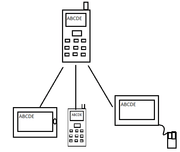Mobile Web Server
A Mobile Web Server is software designed for modern-day smartphones to host personal web servers, through the use of open sourced software, such as, i-jetty, an open source software, based on jetty. I-jetty is an open source web container, serving Java-based web content such as, servlets and JSPs. Jetty is written in Java and its API is available as a set of JARs. Developers can instantiate a jetty container as an object, instantly adding network and web connectivity to a stand-alone Java app.[2] Jetty is built for scalable performance allowing tens of thousands of HTTP connections and hundreds of thousands of simultaneous web socket connections. Jetty is optimized and known for creating small memory footprints, increasing scalability and performance.
| Original author(s) | Robert McCool |
|---|---|
| Developer(s) | Apache Software Foundation, Nokia Research |
| Initial release | 23 October 2007[1] |
| Stable release | 1.5
/ 18 November 2008 |
| Written in | C, C++, Java |
| Operating system | All POSIX (Linux/BSD/UNIX-like OSes), Symbian OS, S60 platform, Android (operating system) |
| Available in | English |
| Type | Web server |
| License | Apache License 2.0 |
| Website | https://code.google.com/p/i-jetty/ |
Nokia one of the few cellphone companies brought Apache HTTP Server to their line of Nokia cellphones, running Symbian OS S60 mobile software platform. The S60 Mobile Web Server enables connectivity for HTTP traffic to a mobile device from the Internet.
The Mobile Web Server components include a gateway application that runs on a computer with Internet access and a connector application, that runs on the remote mobile device. The gateway and the connector applications with a valid DNS configuration can provide a mobile device with a global web address (URL). However, as of January 2010, the web server project has been discontinued by Nokia.[3]
Examples
The Mobile Web Server application allows mobile devices a means for hosting personal web applications, including, web pages and server side control. The most commonly used HTTP servers and servlet containers currently available are Jetty, Tomcat, Glassfish and Resin.
 |
The diagram on the left demonstrates a general understanding of a mobile device containing a servlet container, such as, Jetty, Tomcat, Glassfish and Resin. Allowing global hosting through a personalized device, creating functionality and complete user control. Configurations within the Mobile Web Server allows optimization, account management and instant synchronized information across all platforms, regardless of a desktop, laptop or cellphone. |
Web Container Comparison
| Different Containers and versions | Java API (Version) | Ant tasks (Version) | Maven 2 plugin (Version) |
|---|---|---|---|
| GlassFish 2.x | 1.0.1 | 1.0.1 | 1.0.1 |
| GlassFish 3.x | 1.0.1 | 1.0.1 | 1.0.1 |
| Jetty 4.x | 0.1 | 1.0 | 0.2 |
| Jetty 5.x | 0.8 | 1.0 | 0.2 |
| Jetty 6.x | 0.8 | 1.0 | 0.2 |
| Jetty 7.x | 1.0.1 | 1.0.1 | 1.0.1 |
| Jetty 8.x | 1.1.3 | 1.1.3 | 1.1.3 |
| Jetty 9.x | 1.3.0 | 1.3.0 | 1.3.0 |
| Resin 2.x | 0.1 | 0.1 | 0.1 |
| Resin 3.x | 0.1 | 0.1 | 0.1 |
| Resin 3.1.x | 1.2.0 | 1.2.0 | 1.2.0 |
| Tomcat 4.x | 0.1 | 0.1 | 0.1 |
| Tomcat 5.x | 0.1 | 0.1 | 0.1 |
| Tomcat 6.x | 1.0 | 1.0 | 1.0 |
| Tomcat 7.x | 1.0.2 | 1.0.2 | 1.0.2 |
Features
- Personal information manager (PIM) Manage phone's address book
- Helix multimedia player
- Send SMS messages using a web browser
- Browse phone's calendar
- Browse camera phone's image gallery via computer
- View received and missed calls
- Get instant messages sent to your phone screen.
- Maintain a blog
- Share presence status
- Online chat
- Manage access rights
- Start mobile site from the web or Settings
- Share mobile site content via RSS feeds
See also
- Python for S60
- Apache Tomcat, alternative open source web server and servlet container
- ApacheBench, a program for measuring the performance of HTTP web servers